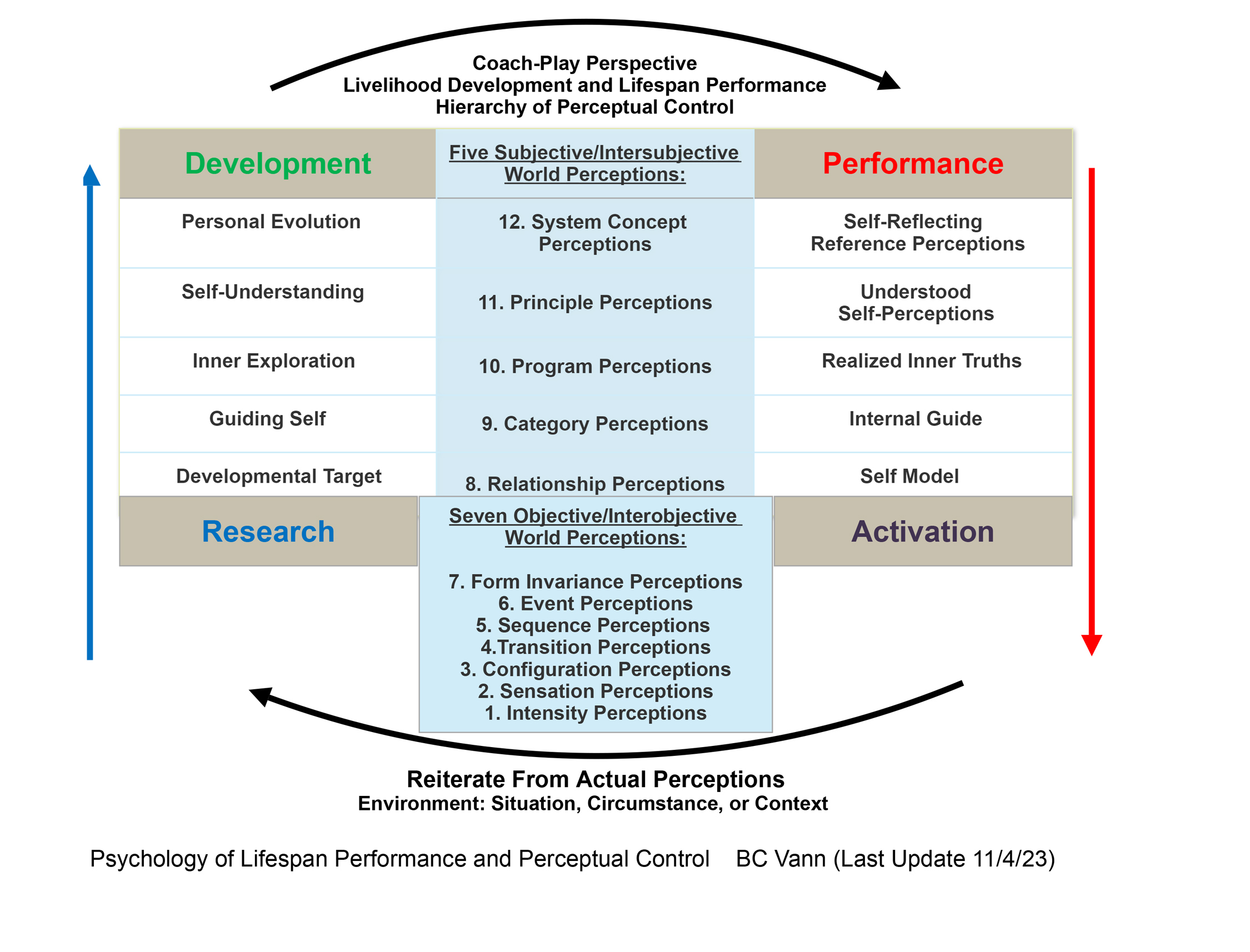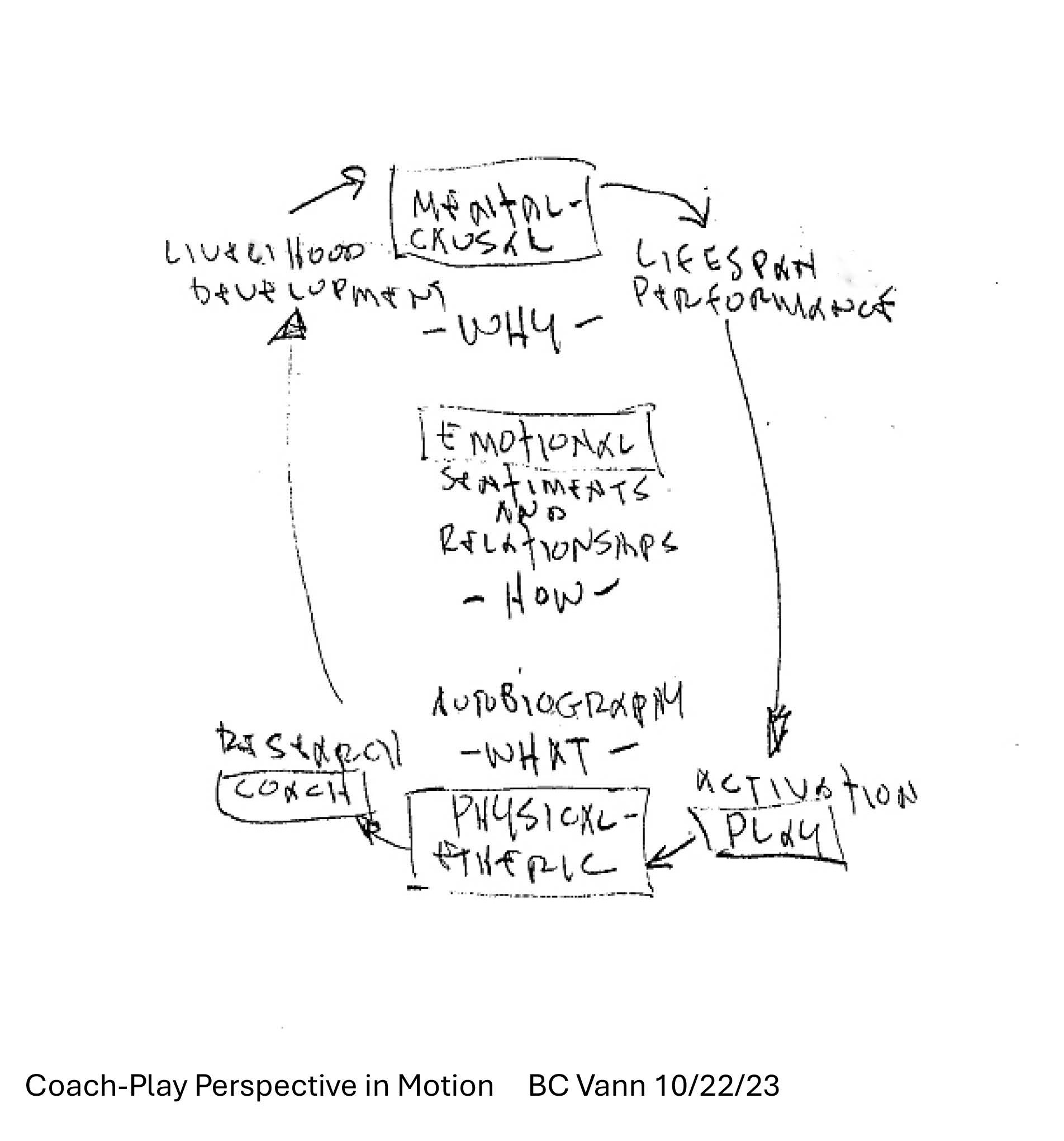As Your Resource For Self-Development
- The Optima Bowling Coach (2025)
Vertical & Systemic Coaching
(Page Update 5/18/25)
During the Vertical & Systemic Coaching epoch, practitioners began to treat growth as a shift in meaning-making orders nested inside multi-level feedback structures. Drawing on constructive developmental theory, complexity science, and Perceptual Control Theory (PCT), coaches locate persistent errors where reference signals from higher-order purposes conflict with lower-order behaviors. Interventions, therefore, target the relationship among control loops—personal, team, organizational, and ecological—rather than any single technique in isolation.
Historical Setting
Robert Kegan’s In Over Our Heads (1994) and later work with Lisa Lahey framed adult development as a progression through qualitatively different ways of organizing experience. Simultaneously, systems thinkers (Peter Senge and Donella Meadows) highlighted how actions reverberate through interdependent structures. PCT provides micro-mechanism: individuals act to reduce perceptual error, while higher-level systems set the reference values that define error.
The workplace shifted toward knowledge networks and rapid innovation; sport expanded from individual contests to data-driven franchise ecosystems; education saw project-based learning aimed at “systems literacy.” Digital connectivity exposed how local improvements could trigger remote disturbances—supply-chain delays, social-media backlash, and climate externalities. Coaches and consultants needed methods recognizing nested feedback and vertical meaning without abandoning deliberate-practice rigor.
Technology matured in parallel. Cloud dashboards aggregated real-time metrics across departments; social-sensing tools captured sentiment; motion-capture and force-plate labs offered physiological precision. Yet information abundance intensified reference conflicts: quarterly revenue targets versus long-term brand integrity, personal wellness versus around-the-clock availability. Vertical & Systemic Coaching emerged to arbitrate those conflicts by aligning reference frames rather than prescribing isolated fixes.
Coaching Expression
Multi-Scale Loop Mapping:
Engagements begin with a diagram of control loops: individual habits, dyadic dynamics, team cadences, organizational policies, societal norms, and biospheric limits. Each loop is labeled with its controlled perception, reference value, and dominant disturbance. The map surfaces conflict (e.g., “fastest delivery” vs. “lowest carbon footprint”) before action planning.
- Order-of-Mind Diagnostics: Borrowing from vertical-development inventories, coaches assess the client’s present meaning-making order—socialized, self-authored, or self-transforming—and tailor interventions accordingly. A team dominated by socialized minds may require explicit norms; a self-authored leader may need dialectical tools to hold competing truths simultaneously. Reference
- Negotiation Sessions: Rather than correcting behaviors directly, coaches convene structured conversations in which stakeholders renegotiate reference signals. For example, a bowling program might redefine “performance” beyond win-loss to include culture scores and lifelong enjoyment indices, thereby recalibrating lower-level practice plans.
- Feed-Forward Experiments: Short, low-risk trials test new loop configurations. A company may pilot a four-day week in one unit; a bowling coach might swap rigid lane-oil patterns for adaptive patterns that shift with player feedback. Data inform loop refinement before wider rollout.
- Meta-Reflection Routines: Participants schedule periodic “loop-about-the-loop” reviews—second-order reflections on whether the control architecture produces the desired stability. This mirrors PCT’s notion of reorganization when chronic error exceeds tolerance.

Development as Nested Perceptual Control
Each developmental plane corresponds to a PCT level that supplies reference signals for the level below:
- LPPC model / Plane PCT Level: Typical Controlled Perception Reference Source during Vertical & Systemic Coaching
- Material-sensory Configuration / Transition: Bowling release angle, heart-rate zone, practice plan, and biometric thresholds
- Relational-emotional Program: Team cohesion index, perceived psychological safety, agreed to team charter, and empathy norms.
- Symbolic-causal Principle / System Concept: Purpose statement, ethical standard, sustainability score, organization’s declared mission, and personal life narrative
Vertical growth occurs when a person shifts attention to a higher control level, notices persistent errors, and negotiates new reference values. Systemic coaching facilitates that shift, ensuring lower loops recalibrate without creating instability elsewhere.
Plane Balance
All three planes receive explicit attention:
- Material-sensory: precise biomechanics, workload tracking, ergonomic audits.
- Relational-emotional: trust surveys, narrative 360s, empathy drills.
- Symbolic-causal: mission rewrites, scenario planning, values-clarification labs.
The distinctive feature is synchronization. Coaches monitor phase alignment so improvements on one plane do not degrade stability on another.

PIE: Coach-Play Perspective in Motion
Performance as The Way of PIE (Purpose, Integrity, Experience) functions here as a Coach-Play dialectic in motion:
- Coach (Purpose) defines or refines reference values at higher control levels.
- Play (Experience) supplies varied disturbances through practice, competition, or experimentation.
- Integrity is maintained when feedback quickly completes the loop to keep perceptions within tolerance.
Vertical & Systemic Coaching choreographs this motion: a clear purpose is set, practice (play) disturbs the system, feedback tests integrity, and results inform the next purpose iteration. Alignment among nested loops ensures the dialectic scales from individual to institution.
PIE Integration Note
Purpose is negotiated and periodically re-examined, recognizing that higher-order references may evolve. Integrity includes data hygiene, feedback latency, and cross-loop coherence. Experience ranges from micro-skills sessions to whole-system simulations. The triad operates at every scale, but systemic coaching ensures no element dominates to the detriment of the others.
Carry-Forward Legacy
- Loop Mapping Tools Network analysis software, value-stream maps, and causal-loop diagrams embed the PCT architecture in everyday consulting.
- Adaptive Protocols Agile sprints, OKR cycles, and learning sprints echo feed-forward experimentation.
- Order-Aware Leadership Many executive education programs now teach vertical development frameworks alongside strategic planning.
Ongoing challenges include diagnostic overhead, potential analysis paralysis, and the temptation to treat systemic mapping as an end rather than a guide for iterative practice.
Reflection Prompt
Sketch three control loops that shape your current project: one personal habit, one team norm, and one organizational policy. For each loop, list its controlled perception and reference value. Identify any conflict among the references. Draft one small experiment (change a reference or disturbance) and schedule a review date to evaluate system stability.
See Next: Augmented Meta-Reflexivity
Back To: Cognitive–Deliberate Practice
See Related: Researching Perceptual Control
See Related: The Purposeful PIE